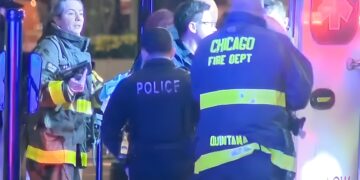
By Nancy Thorner –
This nation is now debating about when and how to open schools in the fall.
Getting kids back to school is now the coronavirus’s latest political football, even though an abundance of evidence and experience shows it shouldn’t be.
Some people believe schools should remain closed due to coronavirus. People with this outlook often suggest virtual learning as an alternative to children and students gathering in classrooms for in-person education. Unfortunately, A rising wave of school districts are sticking with full-time remote learning.
As this article explains:
“The classroom is the real, tangible, touchable place to teach and to learn. It is the place where teachers engage students, encourage participation from the entire class and expand on the thoughts and ideas raised by students. These interactions cannot be duplicated in a virtual classroom.”
Support by President Trump
On Tuesday July 7, 2020, President Trump announced his support for opening the country's schools this fall.
We hope that most schools are going to be open. We don't want people to make political statements or do it for political reasons. They think it's going to be good for them politically, so they keep the schools closed. No way.
So we're very much going to put pressure on governors and everybody else to open the schools. To get them open and it's very important. It's very important for our country. It's very important for the well-being of the student and the parents. So we're going to be putting a lot of pressure on opening the schools in the fall.
Also on June 7, 2020, Education Secretary
Betsy DeVos said
during a call with governors that she expects schools to be “fully operational” in the fall, rejecting plans by some
school districts to offer partial in-person learning.
In response to DeVos, House Speaker
Nancy Pelosi said on CNN's "State of the Union" on Sunday, June 12, 2020, that Education Secretary Betsy DeVos'
aggressive push to fully reopen schools this fall is “malfeasance and dereliction of duty," accusing the Trump administration of "messing with the health of our children."
As Dr. Scott Atlas, now a senior fellow at the Hoover Institution,
told host Martha MacCallum:
"I’m not sure how many times it has to be said, but the risk to children from this disease and the fatality is nearly zero. The risk of children for a significant illness is far less from the seasonal flu … This is totally antithetical to the data.”
What raised the ire of Democrats was on Wednesday, June 8, 2020, when President Trump on Twitter
threatened to withhold money from schools that don't open in the fall:
“May cut off funding if not open!"
To this the media ran articles insisting Trump has no authority to cut funding. Democrats likewise ran to microphones claiming Trump doesn’t have the authority to do that.
Politics over science
Polls show that parents want their children back in the classrooms in September. Who then is opposed to opening schools? Take a guess. The teacher unions.
"The 35,000 members teacher union of the Los Angeles Unified School District are shamelessly holding children for a Democrat agenda, having released a
list of demands that it argues must be met before schools can reopen in America’s second-largest city." They include "defunding of police, a federal bailout of LA schools, and the abolition of charter schools."
"Unfortunately, the teachers’ unions say that without significantly more rules – and more spending – those reopenings aren’t going to happen. Illinois’ unions have
already warned that the state’s recently announced reopening plan doesn’t do enough. They say districts must embrace smaller class sizes, social distancing, alternate school days, additional medical staff and more remote learning for teachers and students to be safe. If the state and local districts don’t do – and fund – everything the unions want, look for teachers to oppose opening schools this fall."
Important statistics noted by Dabrowski and Klingner:
- Across Illinois as of July 6, only four children under the age of 20 have died due to COVID-19. In total, they make up just 0.06 percent of all virus deaths in the state.”
- At "least two of Illinois’ younger victims had comorbidities, according to a Wirepoints analysis of Cook County Medical Examiner data."
- "Nationwide, deaths for children under the age of 15 now total just 29."
As
to how other countries are dealing with sending their children back to school despite the coronavirus, noted below are children in Denmark, Germany, France, and Sweden:
Denmark was the first European country to reopen primary schools and kindergartens, doing so in mid-April. Secondary students started returning to class on 18 May.
In Germany many states are aiming to have all classes in schools and kindergartens return before the start of the summer break, which starts as early as 22 June in some parts of the country.
In France since the country’s lockdown was lifted on 11 May, 40,000 primary schools have reopened, along with some secondary schools
In Sweden, in keeping with country’s soft-touch approach to lockdown, schools have remained open during the pandemic. Authorities have relied on social distancing and hygiene measures to reduce the spread of infection instead]
Science for opening schools
No less than the American Academy of Pediatrics
recommends that “all policy considerations for the coming school year should start with a goal of having students physically present in school” and that “policies to mitigate the spread of COVID-19 within schools must be balanced with the known harms to children, adolescents, families and the community by keeping children at home.
As
Michelle Cretella, M.D. executive director of the American College of Pediatricians told
Heartland's Health Care News:
“Nothing and no one can replace parents and family relationships, however, the unprecedented long-term closure of schools has been disruptive and destabilizing for many youths who thrive on routine and socialization. For children already dealing with mental illness and/or special education needs, school closures have meant lack of access to services they received from school counselors, psychologists and therapists. While remote interaction is better than no contact at all, it is not as effective as face to face interactions with family, friends, teachers and therapists. Human beings, especially children, need face to face warmth and human touch."
“In short, there is a growing chorus of physicians reminding folks that, ‘there is more to health than avoiding COVID-19.”
Said Meg Edison, M.D., a Michigan pediatrician and policy advisor to
The Heartland Institute, which publishes
Health Care News:
“Anxiety and depression in older kids is spiking, as many teenagers their life on hold and all the social activities and sports that bring joy and build community cancelled.”
"School-aged children between the ages of five and 14 have a one in 200,000 chance of dying from influenza but a one in 2.5 million chance of dying from COVID-19. Children aged from one to four have an even lower chance of fatality from COVID-19: they are 20 times more likely to die of the flu than of COVID-19."''
Those statistics make a solid case for reopening schools, especially pre-K through junior high, the report states. Reopening schools could also make it easier to reopen certain parts of the economy, as workers will not have to worry about childcare or leaving their children at home during school hours.”
A
study at
Institut Pasteur in France confirms that "children appear to show fewer telltale symptoms than adults and be less contagious, providing a justification for school reopenings in countries from Denmark to Switzerland. The researchers found that 61% of the parents of infected kids had the coronavirus, compared with about 7% of parents of healthy ones, suggesting it was the parents who had infected their offspring rather than the other way around."
Reason instead of fear
While research still suggests that while children can be infected with COVID-19, it is uncommon. They also don't seem to pass the disease on as efficiently as adults do, and cases of child-to-child infection are uncommon. And when children do get infected, they don't seem to get very sick.
Why should things differ in this nation about reopening schools than in Europe where schools have already opened up or are planning to do so shortly, except for politics in what is a presidential election year here in the U.S.
Teacher unions and lobbyists constitute powerful voices on the Left in deciding school policy, helped along by a mainstream media that continues to scare the public through its false and exaggerated narratives about the current nature of the coronavirus pandemic.
Related







